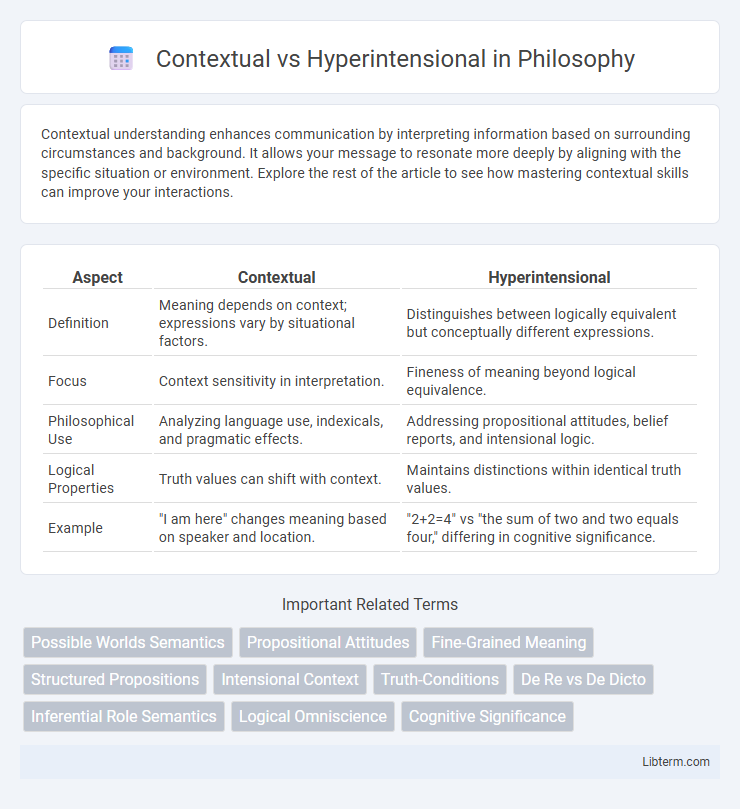Contextual understanding enhances communication by interpreting information based on surrounding circumstances and background. It allows your message to resonate more deeply by aligning with the specific situation or environment. Explore the rest of the article to see how mastering contextual skills can improve your interactions.
Table of Comparison
| Aspect | Contextual | Hyperintensional |
|---|---|---|
| Definition | Meaning depends on context; expressions vary by situational factors. | Distinguishes between logically equivalent but conceptually different expressions. |
| Focus | Context sensitivity in interpretation. | Fineness of meaning beyond logical equivalence. |
| Philosophical Use | Analyzing language use, indexicals, and pragmatic effects. | Addressing propositional attitudes, belief reports, and intensional logic. |
| Logical Properties | Truth values can shift with context. | Maintains distinctions within identical truth values. |
| Example | "I am here" changes meaning based on speaker and location. | "2+2=4" vs "the sum of two and two equals four," differing in cognitive significance. |
Introduction to Contextual vs Hyperintensional Distinctions
Contextual distinctions involve variations in meaning based on situational factors or linguistic context, emphasizing how the truth value of statements can depend on external parameters such as speaker intentions or environmental cues. Hyperintensional distinctions, by contrast, capture differences finer than those accounted for by intensional logic, distinguishing between necessarily equivalent but conceptually distinct propositions or content. Understanding these distinctions is crucial for fields like semantics, logic, and philosophy of language, where precise analysis of propositional attitudes and meaning variability is essential.
Defining Contextuality in Semantics
Contextuality in semantics refers to the dependence of meaning on the situational context, where the interpretation of expressions varies with factors such as speaker intentions, time, place, and conversational environment. This contrasts with hyperintensional contexts, which require precise, fine-grained distinctions in meaning beyond standard intensional logic, often involving intensional operators and propositions. Defining contextuality emphasizes dynamic semantic frameworks that model how context shapes meaning, enabling pragmatic enrichments and indexical references within natural language understanding.
Exploring Hyperintensionality: Core Concepts
Hyperintensionality examines distinctions between expressions that are indistinguishable in all contexts yet differ in fine-grained meaning, such as "necessarily true" versus "logically true." It challenges the classical intensional semantics by accounting for the failure of substitutivity of synonymous expressions in certain contexts, emphasizing the precision of propositions beyond truth values. Core concepts include fine-grained meanings, non-substitutivity, and the analysis of cognitive significance and propositional attitudes.
Key Differences Between Contextual and Hyperintensional Approaches
Contextual approaches analyze meaning based on varying contexts, capturing how linguistic expressions shift interpretation depending on factors like speaker intention, time, or location. Hyperintensional approaches, by contrast, deal with meanings at a finer granularity, distinguishing between expressions that are logically equivalent yet differ in cognitive or informational content. Key differences lie in sensitivity to logical equivalences and context variations, where contextual semantics tolerates equivalence under similar contexts, while hyperintensional semantics preserves distinctions critical for intensional operators and fine-grained meaning analysis.
Historical Evolution of Both Theories
The historical evolution of contextual and hyperintensional theories demonstrates a shift from classical logic's emphasis on context-dependent truth conditions towards hyperintensional frameworks that capture finer semantic distinctions beyond mere substitution of co-referential terms. Contextual theories, rooted in early pragmatics and Fregean semantics, evolved through developments in possible world semantics by philosophers such as Kaplan and Stalnaker, emphasizing context sensitivity in meaning determination. Hyperintensional approaches gained prominence in the late 20th century through work in intensional logic and cognitive science, addressing limitations of contextual theories by modeling meanings that differ even under necessarily equivalent expressions, impacting fields like knowledge representation and natural language understanding.
Applications in Linguistics and Philosophy
Contextual semantics analyzes meaning based on situational context and speaker intention, crucial for natural language understanding and pragmatic interpretation in linguistics. Hyperintensional logic captures fine-grained distinctions between propositions that are necessarily equivalent but differ in cognitive content, enhancing philosophical analysis of belief, knowledge, and meaning. Applications in linguistics include disambiguation and reference resolution, while philosophy utilizes hyperintensionality to address intensional contexts and propositional attitudes.
Examples Illustrating Contextual and Hyperintensional Meanings
Contextual meanings depend on the surrounding text or situation, such as "bank" referring to a river edge or a financial institution based on context. Hyperintensional meanings go beyond context by distinguishing between expressions that refer to the same entity but differ in cognitive significance or informational content, like "Morning Star" and "Evening Star," both names for Venus but conveying different informational perspectives. Examples illustrating this include sentences that are interchangeable in truth conditions (contextual) but not interchangeable in intensional or hyperintensional contexts, demonstrating subtle semantic distinctions important in logic and linguistics.
Challenges in Distinguishing Contextuality and Hyperintensionality
Distinguishing contextuality from hyperintensionality presents challenges due to their overlapping effects on meaning variance in linguistic expressions. Contextuality depends on shifts in context or possible worlds, while hyperintensionality targets fine-grained distinctions beyond logical equivalence, complicating semantic analysis. This overlap often leads to difficulties in isolating context effects from intensional differences in natural language semantics and formal logic frameworks.
Contemporary Debates and Criticisms
Contemporary debates in philosophy of language critically contrast contextual and hyperintensional approaches, emphasizing their differing capacities to capture meaning sensitivity. Contextual theories, which rely on context-dependent interpretation, face criticism for failing to adequately address fine-grained distinctions in meaning, especially in propositional attitude ascriptions. Hyperintensional frameworks respond by providing tools to represent subtle semantic differences, yet they are challenged for increased complexity and potential undermining of compositionality in semantic analysis.
Future Directions in Semantic Theory
Future directions in semantic theory emphasize refining the distinctions between contextual and hyperintensional semantics by developing models that better capture fine-grained meaning variations in natural language. Advances in formal logic and computational linguistics aim to integrate context-sensitive interpretations with hyperintensional operators, facilitating more precise analysis of belief, intention, and propositional attitudes. Ongoing research explores dynamic frameworks and probabilistic semantics to enhance the expressiveness and applicability of semantic theories in real-world language understanding.
Contextual Infographic

 libterm.com
libterm.com